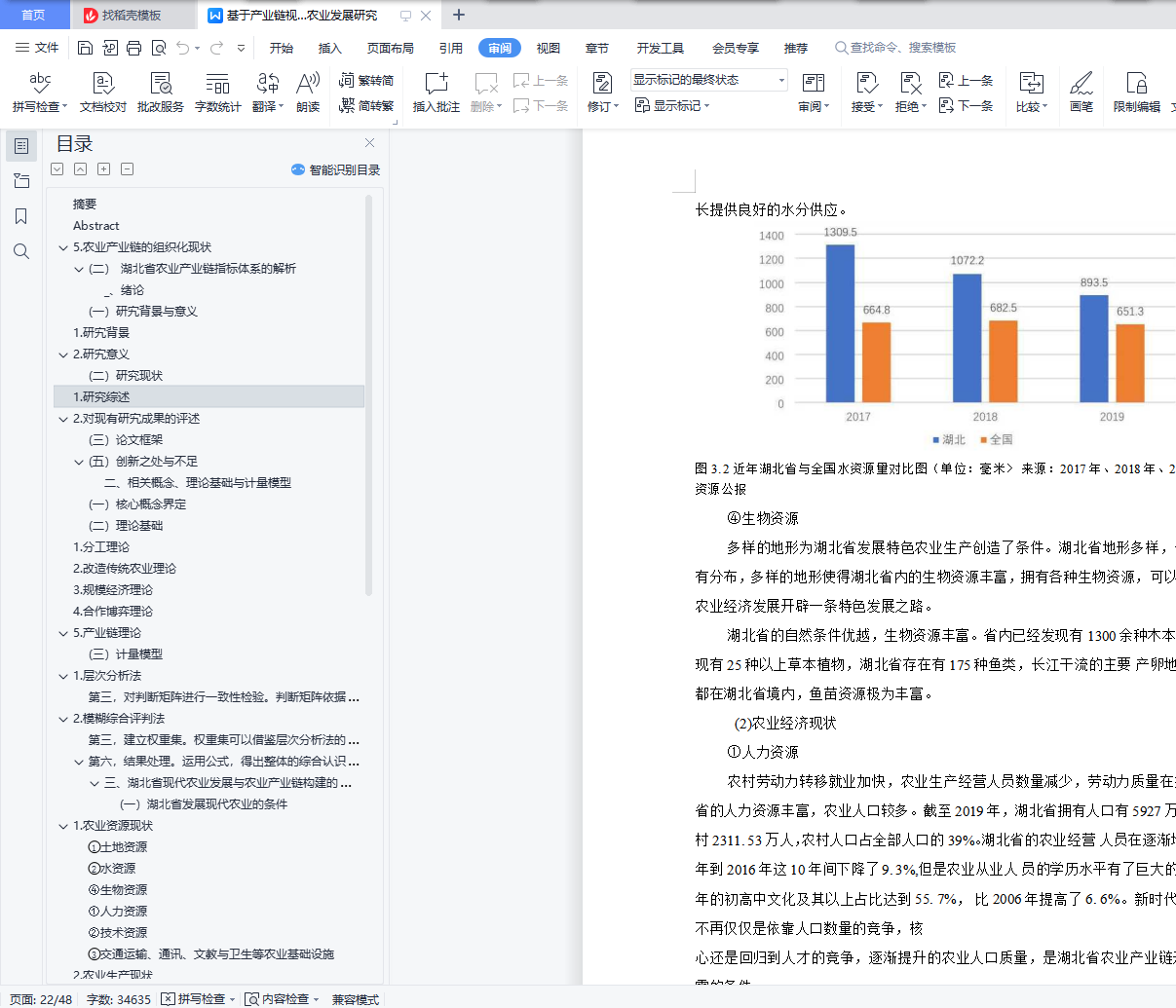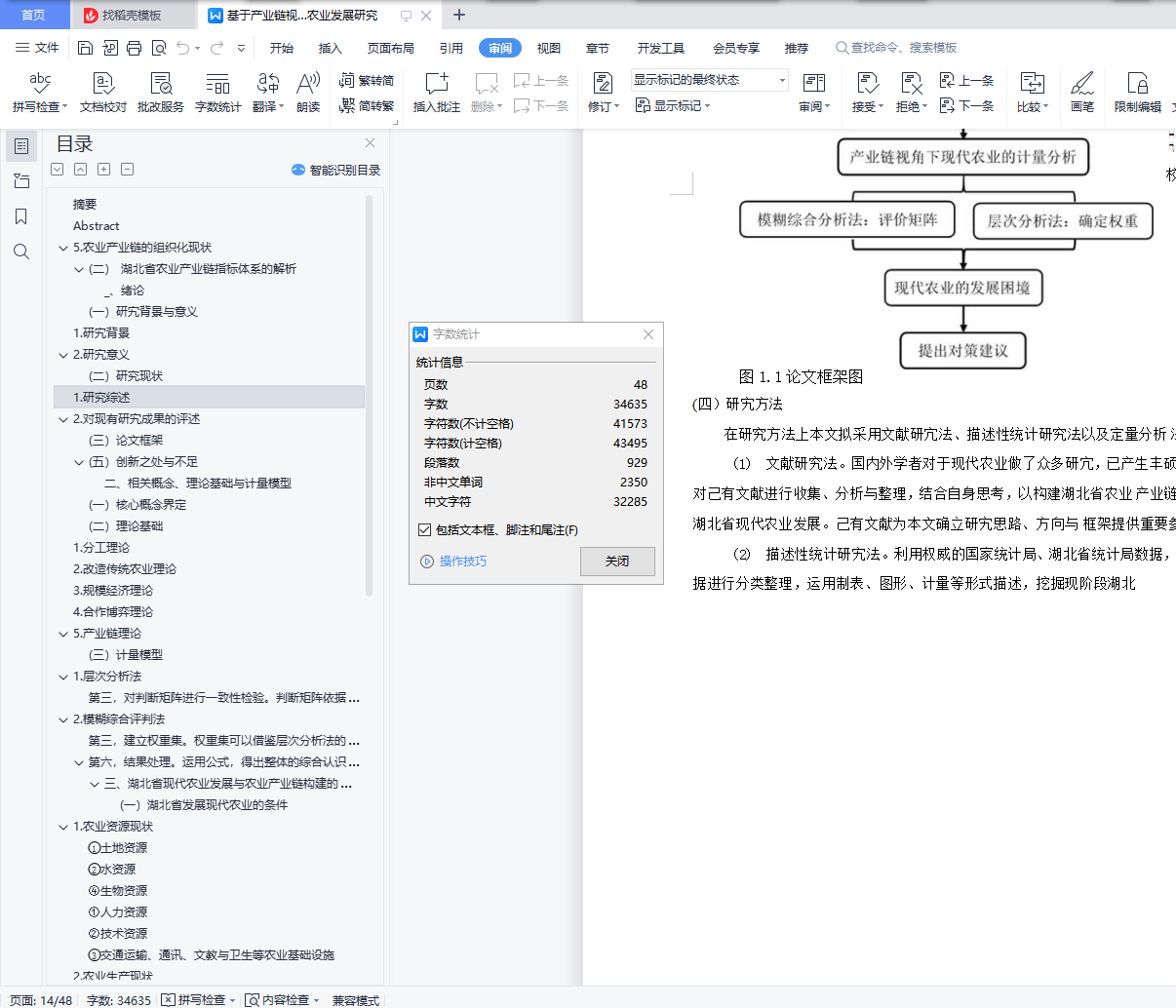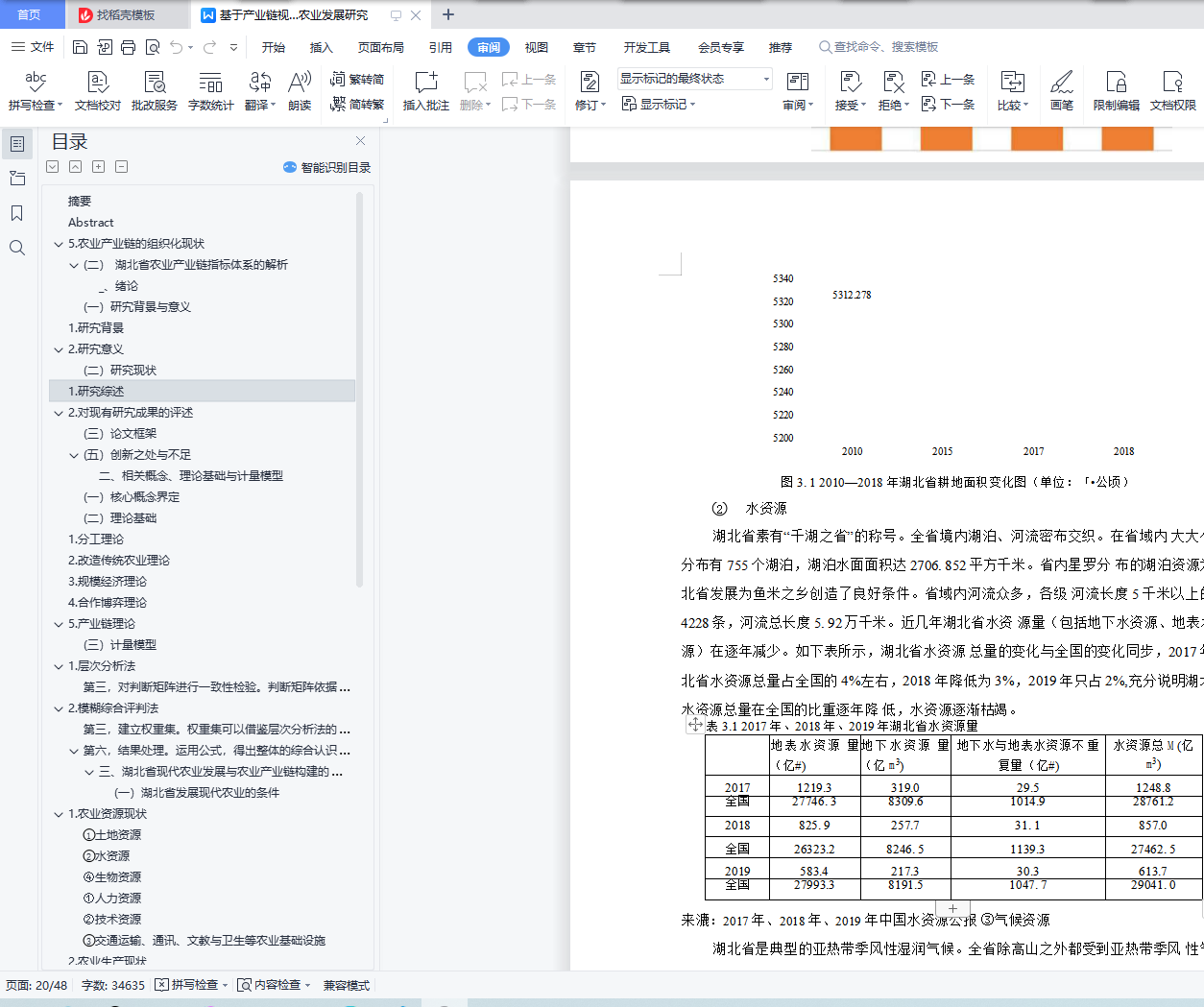摘要
农业农村农民是关系国计民生的根本问题,为更好地做好三农工作,推动现 代农业发展成为必要举措。农业产业链是现代农业的重要形式,可以将现代农业 的内涵完整体现出来。为更好地研究湖北省现代农业发展现状,本文构建农业产 业链的指标体系,以湖北省农业产业链的长度、宽度、厚度与贡献度方面的价值 评价来分析湖北省现代农业发展状况,并提出针对性的对策建议。
首先说明文章的研宄背景、研宄现状、相关理论以及计量模型;其次具体分 析湖北省现代农业的发展潜力,探宄农业资源状况,以农业产业链视角分析现代 农业在生产、加工、销售等环节的现状;再次构建湖北省农业产业链的指标评价 体系,收集整理数据,发现湖北省现代农业在产业视角下出现的问题;最后提出 推动湖北省现代农业发展的对策建议。本文利用调查问卷、访谈等方式,调查了 20位对湖北省现代农业有一定研宄的专家学者,通过打分的方式获取数据,采 取实证分析,发现湖北省现代农业发展对产业链的要求与农业产业链发展的实证 分析结果之间存在矛盾,需要找准存在的问题,提出针对性的对策建议,推动湖 北省现代农业高质量发展。
借助农业产业链的指标体系构建分析现代农业的基本框架,依靠层次分析与 模糊综合分析相结合的方法对湖北省农业产业链的发展现状进行分析,发现湖北 省农业产业链长度处于一般状态、宽度较为满意、厚度和贡献度也是一般,整体 发展水平处于一般到满意之间,处于平均水平之上。但是农业产业链节点分散、 资源挖掘不够、市场竞争力不强、社会贡献较小等问题。针对性地提出对策建议, 首先要深化产权改革与增强利益联结,为湖北省现代农业发展做好基础工作,再 采取措施实现规模化、商品化、组织化以及智能化要求。
关键词:产业链;现代农业;价值指标体系
Abstract
Agricultural and rural fanners are a fundamental issue related to the national economy and people's livelihood. In order to do a better job in agriculture, rural areas and fanners, it is necessary to promote the development of modem agriculture. The agricultural industry chain is an important form of modem agriculture, which can fully reflect the connotation of modem agriculture. In order to better study the status quo of modern agriculture development in Hubei Province, this article constructs an indicator system for the agricultural industry chain, and analyzes the development status of modern agriculture in Hubei Province based on the value evaluation of the length, width, thickness and contribution of the agricultural industry chain in Hubei Province. Propose targeted countermeasures.
First, explain the research background, research status, related theories and measurement models of the article; secondly, analyze the development potential of modem agriculture in Hubei Province, explore the status of agricultural resources, and analyze the status quo of modem agriculture in production, processing, and sales from the perspective of the agricultural industry chain ; Once again construct the index evaluation system of the agricultural industry chain in Hubei Province, collect and sort out the data, and discover the problems of Hubei Province's modem agriculture from the industrial perspective; finally put forward countermeasures and suggestions to promote the development of Hubei Province’s modern agriculture. This article uses questionnaires, interviews and other methods to survey 20 experts and scholars who have some research on modern agriculture in Hubei Province, obtain data through scoring methods, and take empirical analysis to find that the development of modern agriculture in Hubei Province requires the industrial chain and the agricultural industry. There are contradictions between the empirical analysis results of chain development, and it is necessary to find out the existing problems and put forward targeted countermeasures to promote the high-quality development of modern agriculture in Hubei Province.
Relying on the indicator system of the agricultural industry chain to construct the basic framework for analyzing modem agriculture, and relying on the method of combining analytic hierarchy and fuzzy comprehensive analysis to analyze the development status of the agricultural industry chain in Hubei Province, it is found that the length of the agricultural industry chain in Hubei Province is in a general state and width. Relatively satisfactory, thickness and contribution are also average, and the overall development level is between average and satisfactory, which is above the average level. However, there are problems such as scattered nodes in the agricultural industry chain, insufficient resource mining, weak market competitiveness, and small social contribution. To put forward countenneasures and suggestions in a targeted manner, we must first deepen the reform of property rights and strengthen the connection of interests, and do a good job of basic work for the development of modern agriculture in Hubei Province, and then take measures to achieve the requirements of scale, commercialization, organization and intelligence.
Key Words: industrial chain; modem agriculture; value index system
目录
谢仑 1
(一) 研宄背景与意义 1
1•研究背景 1
2.研宄意义 1
(二) 研宄现状 3
1. 研宂综述 3
2. 对现有研究成果的评述 8
(三) 论文框架 9
(四) 研究方法 10
(五) 创新之处与不足 11
二、 相关概念、理论基础与计量模型 12
(一) 核心概念界定 12
(二) 理论基础 12
1 •分工理论 12
2•改造传统农业理论 13
3. 规模经济理论 13
4. 合作博弈理论 13
5. 产业链理论 14
(三) 计量模型 14
1.层次分析法 14
2•模糊综合评判法 15
三、 湖北省现代农业发展与农业产业链构建的现状 17
(一) 湖北省发展现代农业的条件 17
1. 农业资源现状 17
2. 农业生产现状 21
3. 农产品加工业现状 22
4. 农产品储存、流通及销售现状 22
5. 农业产业链的组织化现状
(二) 湖北省农业产业链指标体系的解析
1•农业产业链的长度指标 23
2•农业产业链的宽度指标 24
3. 农业产业链的厚度指标 24
4. 农业产业链的贡献度指标 25
(三)发展现代农业对构建农业产业链的要求 26
四、 湖北省农业产业链发展水平的测度 28
(一) 指标权重的确定 28
1•准则层权重的确定 28
2. 确定指标层权重 28
3. 评价指标体系权重的确定 29
(二) 确定评价集 30
(三) 湖北省农业产业链测度实证 30
1.利用评价结果构建模糊评价矩阵 31
2•指标层测度 31
3. 准则层测度结果 32
4•产业链测度结果 32
(四) 湖北省农业产业链发展存在的问题 32
1. 农业产业链节点分散 32
2. 农业产业链的资源挖掘不够 33
3•农业产业链的市场竞争力不强 34
4. 农业产业链的社会贡献较小 34
五、 推进湖北省现代农业高质量发展的对策建议 36
(一) 以产权改革化解制度困境 36
(二) 以利益联结稳定发展基石 36
(三) 以三产融合实现规模化目标 37
(四) 以地区特色实施商品化策略 37
(五) 以主体培育创新组织形式 38
(六) 以科技创新增强智能化水平 39
参考文献 40
麵 45









